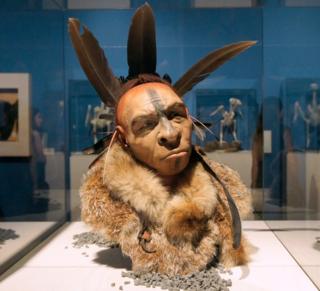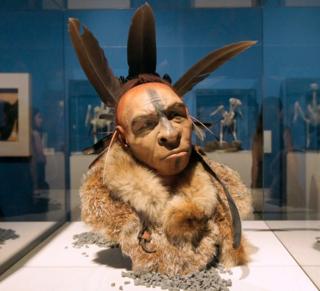Neanderthals ‘dived in the ocean’ for shellfish
Until now, there’s been little evidence our evolutionary relatives could swim. …

 Image copyright Science Photo Library
Image copyright Science Photo Library New data suggests that our evolutionary cousins the Neanderthals may have been diving under the ocean for clams.
It adds to mounting evidence that the old picture of these ancient people as brutish and unimaginative is wrong.
Until now, there had been little clear evidence that Neanderthals were swimmers.
But a team of researchers who analysed shells from a cave in Italy said that some must have been gathered from the seafloor by Neanderthals.
The findings have been published in the journal Plos One.
The Neanderthals living at Grotta dei Moscerini in the Latium region around 90,000 years ago were shaping the clam shells into sharp tools.
Paolo Villa, from the University of Colorado, Boulder, and colleagues, analysed 171 such tools, which all came from a local species of mollusc called the smooth clam (Callista chione). The tools were excavated by archaeologists at the end of the 1940s.
Clam shells that wash up on beaches can be distinguished from those that are still live when they’re gathered.
The beached specimens were opaque, sanded down through being knocked against pebbles on the shore, perforated by other marine organisms and encrusted with barnacles.
Most of the specimens at Grotta dei Moscerini fit the criteria of shells that were collected on a beach.
But one quarter of them had a shiny smooth exterior, showing no signs of such wear and tear. This suggested they were collected from the seafloor while the clams were alive.
Today, Callista chione is most often fished by dredging, using small boats, or gathered by scuba divers in waters off the Adriatic coast that are more than 10m in depth.
In the northern part of the Adriatic, however, there are some sand banks where Callista clams can be collected at depths of between half a metre to one metre. In this case, the clams could be caught just by wading.
But, said Paola Villa: “It’s quite possible that the Neanderthals were collecting shells as far down as two to four metres,” adding, “of course, they did not have scuba equipment.”
Dr Matt Pope, from the Institute of Archaeology at UCL, who was not involved with the study, told BBC News: “We can all come up with exceptional situations where, during a storm event clams get thrown up on a beach.
“But it’s the fact they occur at more than one [archaeological] unit, it’s the fact they occur as part of a system of material being brought further into this cave, that suggests there’s more than just a single, odd event going on.”
The evidence is in stark contrast to our old view of the Neanderthals spending much of their time chasing or scavenging big game animals.
It’s known that Neanderthals gathered mussels from estuaries and fished in shallow waters, but there has been little clear evidence for swimming, skin-diving – or in some cases, perhaps, wading.
“It’s more evidence to place Neanderthals into these coastal environments and at points in time making use of coastal resources, not just for food, but also as a raw material for tools,” said Dr Pope.
He said that decades ago, this type of resource-gathering had been used to distinguish early examples of our own species, Homo sapiens, from the Neanderthals. “We can’t find that distinction any more,” he said.
“What’s nice about this paper is that it covers a site which at particular points in time, when you’ve got high sea levels… is right on the coast. You can see that they’re not living there in large numbers for long periods of time. it looks like they’re making short trips and they’re coming equipped – bringing materials that they might need, such as pre-existing tools.”
“Maybe it’s a place where they camp seasonally, at particular times of the year. Maybe one of the things that’s drawing them there are these shellfish, which are wonderful things to be eating through the winter when there’s not a lot of other dependable food around.”
Last year, a team led by Prof Erik Trinkaus from Washington University in St Louis, US, published evidence showing that many Neanderthals suffered from a medical condition called “surfer’s ear”.
This condition is characterised by abnormal bony growths that appear in the ear canal. It’s often seen in people who take part in aquatic sports in cold climates, but it can occur simply because of repeated exposure to cold, wet weather.
At the time the paper was released, there were suggestions Neanderthals could have got it from sleeping on chilly, damp cave floors.
“The archaeological evidence from Moscerini supports the idea of frequent aquatic resource exploitation based on anatomical data,” Paola Villa and colleagues write in the latest paper.
Follow Paul on Twitter.


